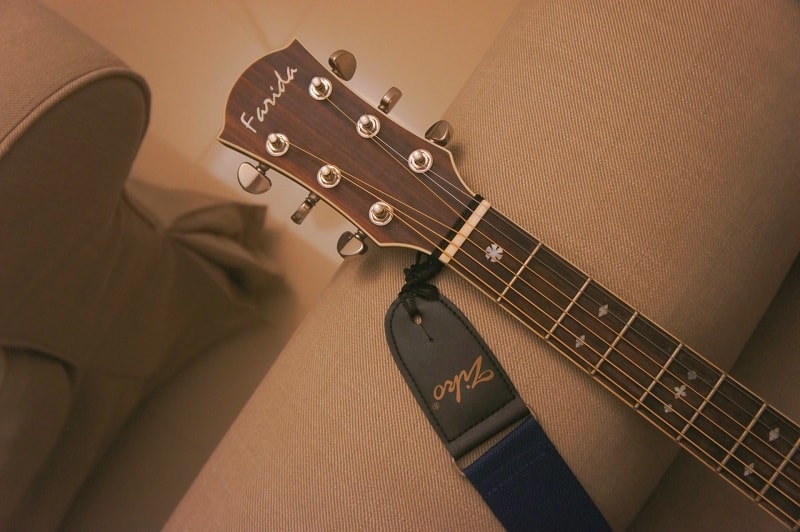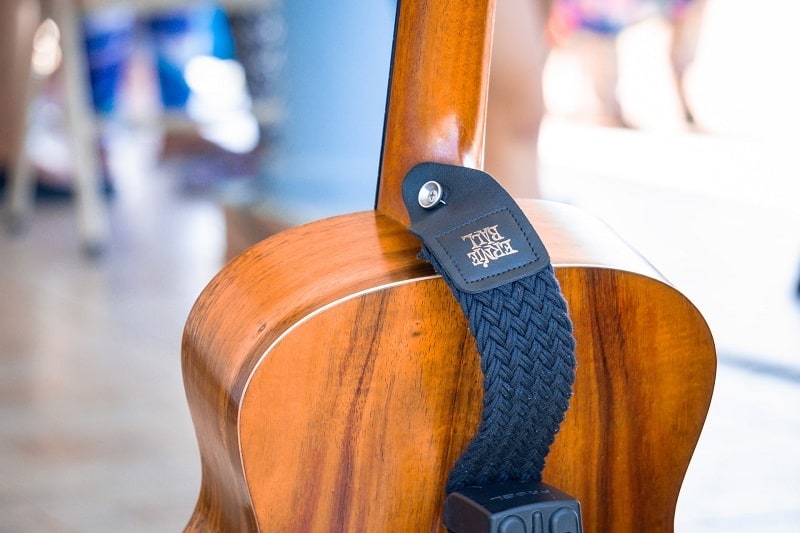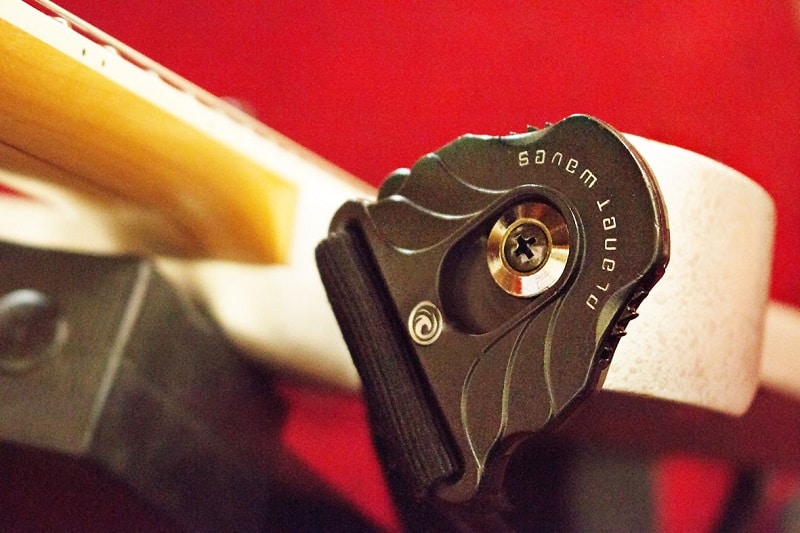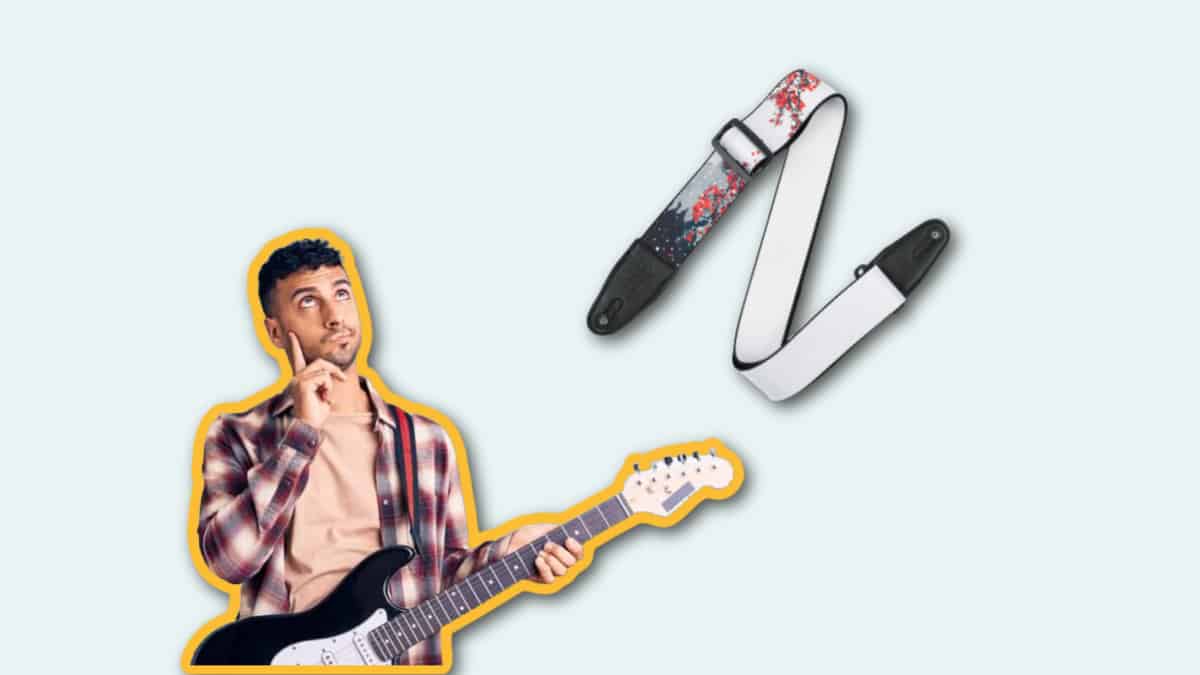You may be thinking, “What do you mean, how to wear a guitar strap? How hard can it be?” And to a degree, you’d be right – you just sling it on, and get down to musical business.
When I started playing electric guitar, I modeled my style off of my favorite guitarist, Brian May (from Queen). My best friend, though, chose to honor Billie Joe Armstrong (from Green Day).
If you see a picture of these two guys next to each other, the way they hold their guitars is quite different. And the difference is all in the strap.
Now, I’m not saying if you change your strap you’ll suddenly be able to play like Brian May. I wish! But the way you wear your guitar strap can have an effect on your playing.
It’s partly about personal preference as well. But if you aren’t quite reaching the notes you want to, or you’re having trouble playing as fast as you’d like, the problem may be all in that little strip lying on your shoulder!
Let’s dive in and see which approach will work the best for you.
Types of Straps
Firstly, let’s check out what types of straps are around and who should use which type.
The type of strap you use could make a bit of a difference to how to wear a guitar strap correctly.
There are three main types of strap attachments, and most straps fall into one of these categories:
- Loop and string
- Loop and buttons
- Locking mechanisms
Loop & String
These types of straps are mostly used by acoustic guitarists whose guitar doesn’t have a strap button or stud near the neck. That leaves them no option but to tie the end of the strap to the guitar neck.

Most acoustic guitars these days do come with a neck button, though. So this type of strap may be more common for classical guitarists who would rather play standing up than sitting.
Loops & Buttons
This type of strap is more versatile. In fact, this is the one you’ll see most often.

You can wear one of these with an electric or an acoustic, as long as you have two buttons on your guitar – one on the bottom of the guitar and one near the neck.
The buttons are easy to install on a guitar body, too, so this is an option even if you have an acoustic that’s missing the neck button.
Locking Mechanisms
Some straps come with a locking mechanism that you can tighten to prevent any chance of the strap slipping off the button while you’re playing.

There are various kinds of locking mechanisms, which I won’t go into, because you’ll definitely know if you have one or not!
These are most often used on electric guitars, because the locks can be big and uncomfortable to fit on an acoustic guitar’s body.
How To Wear a Guitar Strap
There are really only two ways you can wear your strap – low or high.
Some believe that you should wear your strap so the guitar sits in the same position it would if you were sitting and playing.
Because it essentially comes down to personal preference (and comfort), we’ll compare the two in a variety of aspects and see which one comes out on top!
Low Hanging Strap
A low-hanging guitar strap is a more modern way of holding the guitar.
You’ll only really see electric guitarists wearing their instruments this low. The low position is great for hitting power chords, which are grungy, two- or three-note chords that are common in rock and heavy metal music.
Another advantage of the lower strap position is that you can really hit those chords hard from higher up.
Some guitarists who wear their guitar like this:
- Billie Joe Armstrong (Green Day)
- Slash (Guns ‘N Roses)
- James Hetfield (Metallica)
- Jimmy Page (Led Zeppelin)
What I Like
- Enables guitarists to hit the chords nice and hard
- Super for robust rhythm guitaring
- Looks real rock-like
What I Don’t Like
- Forces the wrist into an unnatural position.
- Could lead to painful conditions in the long run.
- Can be harder on the back and shoulders.
A low-riding guitar makes you look like a pro. All the cool kids are doing it!
If you’re a rhythm guitarist who’s heavy on the power chords, you could benefit from this position. Coming down from higher up on the strum can give you a bit more power on your down swings.
The biggest downside to playing with your guitar slung low is that it has the potential for injury and wrist pain. Yes – guitarists can get injured too!
Firstly, the wrist. The strumming wrist is likely to be all good, but the fret wrist is open to the possibility of pain and stiffness. This is because that wrist has to bend a little farther to reach the chords you’re playing.
Obviously, you can tilt the neck upwards when playing to reach the places you need to. But that’s not always possible when you’re playing vigorously.
Secondly, the back and shoulders. Playing way down low may make you look like a rockstar, but you’ll be hunching your shoulders more than you should in order to be able to strum.
Here’s a video that shows Billie Joe Armstrong with his strap strung super low:
High Strap
You’ll see a good many old-school guitarists with their instruments in a high position.
Often, this is the position of choice for guitarists who spend less time strumming and more time playing intricate pieces.
When I first became interested in guitar, my uncle introduced me to Robert Fripp, who wore his guitar waaaaaay up high. I tried it for a bit, but soon noticed that my favorite guitarist wore his slightly lower (but still considered to be a high strap placement).
I found it more comfortable to hold my guitar slightly lower down, somewhere in between under my chin and below the belt!
Some guitarists who wear their guitar up high:
- Brian May (Queen)
- Robert Fripp (King Crimson)
- Eric Clapton
- Hank Marvin (The Shadows)
- BB King (The Blues King)
- Tom Morello (Rage, Audioslave)
What I Like
- Easier to reach all the frets on all the strings.
- More control over playing, great for solos.
- Less strain on the wrist.
- Still very effective for rhythm guitaring.
What I Don’t Like
- May be uncomfortable for some and feel unnatural.
This position is super for soloing (like Tom Morello in the video below) – you have more space to move faster and can easily reach every note on the fretboard without having to get your wrist into an unnatural angle.
It’s also pretty good if you tend to strum quite freely – it allows for more wrist flexibility and movement than the low position.
Because you’re standing up straight and not hunching over as much, there’s also much less chance of back and shoulder pain.
For some, it may feel a little unnatural to wear the guitar so high up on their body and have to bend their arms so much.
To be honest, there aren’t many (if any) more disadvantages to the high strap position!
Here’s an example of Tom Morello, who wears his guitar super high! (He also starts picking with his teeth near the end of this solo, lol.)
Other Things To Consider
Once you’ve decided if you’re a low-strapper or a high-strapper, consider these factors to make sure you’re wearing it right.
Is There A “Right Way Around” For The Strap To Go?
Not officially! But if you want to be able to adjust on-the-go and avoid uncomfortable chafing on your shoulder, it’s a good idea to make sure the adjustable bit is not sitting against your body.
For some, this may mean having it closer to the neck stud. For others, it may work better down by the bottom stud.
Remember that once your strap is adjusted to what’s comfy for you, you probably won’t need to change it again unless it comes loose somehow by accident, or you let a taller/shorter friend borrow it.
Guitar Strap Safety
If you’re using a loop & string strap, you’d want to double-knot the string to avoid an accidental drop if the knot unravels.
A loop & button/stud strap usually comes with leather or leather-like ends with a thin slit-like “loop” cut into them. These can be tricky to slip over the stud, but once they’re on properly they hold pretty well.
Be careful to get them fully over the stud – doing half a job here could result in a dropped guitar.
If you’re a very active player who throws your guitar around a lot, it’s best to double-check these in between songs, although in that case I’d recommend a locking strap.
If your strap begins to break or the loops become stretched, it’s best to start looking for a new one asap.
The Final Verdict
How to wear a guitar strap correctly is a hard thing to pinpoint!
While there are advantages to each, in the end it’s up to you to decide whether you want yours slung low, sitting up high, or somewhere in the middle.
Whatever you choose, make sure to take care of those wrists!

